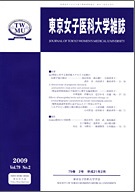Virtual Issue
Volume 93, Issue 1
Displaying 1-9 of 9 articles from this issue
- |<
- <
- 1
- >
- >|
-
2023Volume 93Issue 1 Pages Toc1
Published: February 25, 2023
Released on J-STAGE: March 15, 2023
Download PDF (103K)
Review: Genetic Medicine Update: From Basic Research to Clinical Care
-
2023Volume 93Issue 1 Pages 1-6
Published: February 25, 2023
Released on J-STAGE: March 15, 2023
Download PDF (446K)
Report
-
2023Volume 93Issue 1 Pages 7-12
Published: February 25, 2023
Released on J-STAGE: March 15, 2023
Download PDF (459K)
The 88th Annual Meeting of the Society of Tokyo Women's Medical University's Symposium on "Building Disaster Resilience"
-
2023Volume 93Issue 1 Pages 13-14
Published: February 25, 2023
Released on J-STAGE: March 15, 2023
Download PDF (128K) -
2023Volume 93Issue 1 Pages 15-22
Published: February 25, 2023
Released on J-STAGE: March 15, 2023
Download PDF (1497K) -
2023Volume 93Issue 1 Pages 23-29
Published: February 25, 2023
Released on J-STAGE: March 15, 2023
Download PDF (1668K) -
2023Volume 93Issue 1 Pages 30-34
Published: February 25, 2023
Released on J-STAGE: March 15, 2023
Download PDF (878K) -
2023Volume 93Issue 1 Pages 35-39
Published: February 25, 2023
Released on J-STAGE: March 15, 2023
Download PDF (1431K)
Proceeding
-
2023Volume 93Issue 1 Pages 40-48
Published: February 25, 2023
Released on J-STAGE: March 15, 2023
Download PDF (563K)
- |<
- <
- 1
- >
- >|
